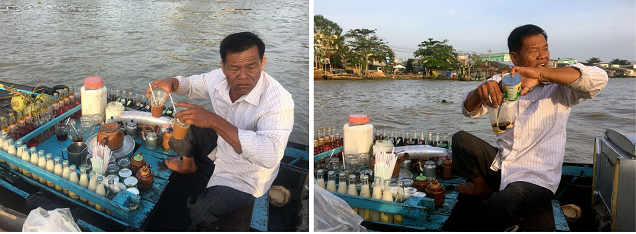Over the years, I’ve found that the key to capturing the right images and having enough photos after a trip to satisfy an editor is to follow these four easy steps:
1. Come up with as many ideas as you can beforehand
I’ve discovered that my cache of images is so much more complete and satisfying when I have a sense of what I’m going to need ahead of time. So, for instance, on a trip to Vietnam last New Year’s, I knew that my story idea on the attitudes of Vietnamese people toward Americans would require plenty of intimate images, like this one of a Hmong woman trading hoop earrings with my friend Tomas as her daughter looks on skeptically.

Much like my interest in these cultural interactions, you want to consider what appeals to you personally about the destination. Activities that match your interests—art, outdoor adventures, cats—are more likely to keep your attention and thus will be easier to remember to shoot as you go along. And because you have some enthusiasm for the subject matter, it’s also likely to make for a good photo story.
2. Research what the publication will likely run
Whether you’ve already sold your photo essay before your trip or have a publication in mind to query afterward, do your research. Spend some time looking at what the publication does online and in print. Believe it or not, sometimes there’s a difference in what they run. Many publications that run large landscapes in print shy away from them online, preferring instead to go with detail shots or themed slideshows.
If there is a print version, I try to get ahold of a hard copy so that I can study the aesthetic. For instance, newspapers tend to look for more general interest photos, and prefer to have people in them.
The majority of lights in this shot are from motorbikes and scooters, but this isn’t the kind of photo a motorcycle lifestyle magazine would print. Instead, it would work well for a newspaper publishing a story on celebrating the holidays in Ho Chi Minh City.

3. Take important shots from a variety of angles
Not only does it make sense to shoot a variety of photos of any given subject to ensure that the best one is in there somewhere, it also comes in handy when you go to sell stories to multiple outlets. Most publications require first rights to photos and stories, so having a variety means that you can divide them up without worrying that you’ll violate your contract.
I took at least 10 photos of this Mekong Delta “coffee guy” in various poses, because I know I’m going to include him in more than one story.

When I start shooting something, I remind myself that I may need more than one of the same subject, so I shift slightly, get down lower, or wait for the people in the frame to move.
4. Zoom in, zoom out
Because so many travel-related publications are looking for sweeping panoramas and landscapes that can be blown up as well as targeted detail shots to sandwich into blank spots on the page, it’s prudent to get both of those composition styles for as many of your subjects.
I’ve run into so many photographers who have a tale to tell of not getting what a publication needed months later, when it was too late.
Ultimately, as the photographer for a story, your job is to help the publications present the best package possible. So, the better prepared you are, the more likely you’ll be successful in selling it.
[Editor’s Note: Learn more about how you can fund your travels and make an extra income with photography, travel writing, blogging, and more in our free online newsletter The Right Way to Travel. Sign up here today and we’ll send you a new report, Five Fun Ways To Get Paid To Travel: A Quick-Start Guide, completely FREE.]
